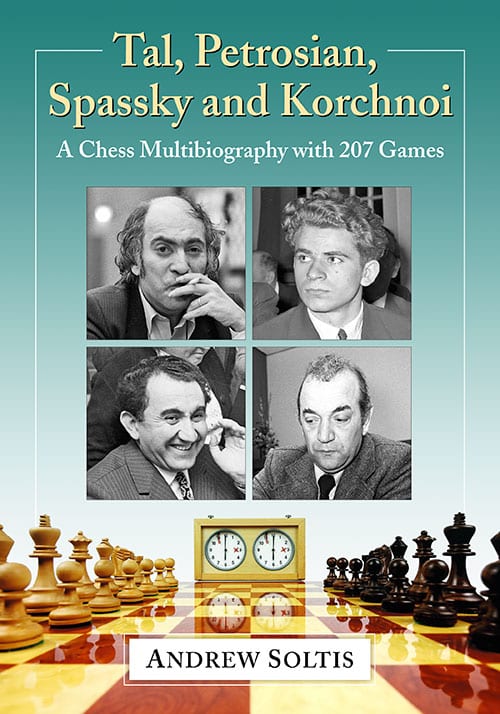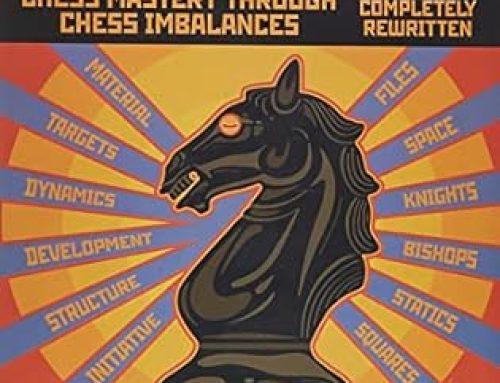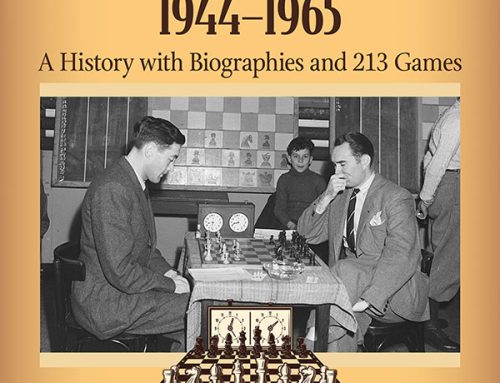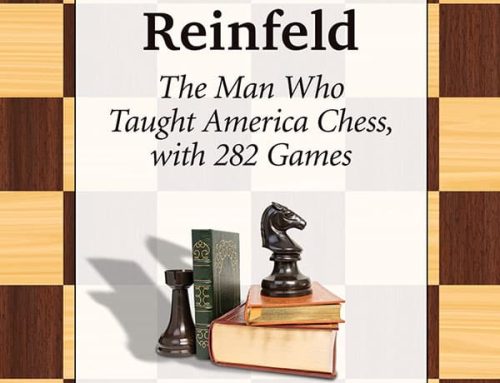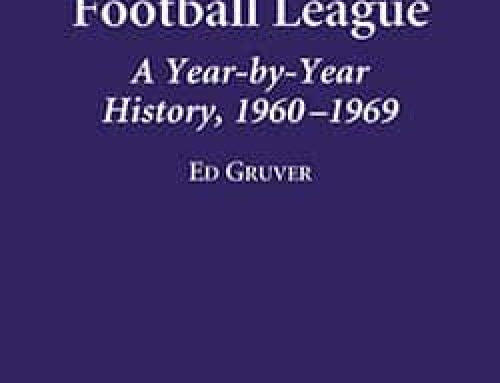Andy Soltis’ new book, Tal, Petrosian, Spassky and Korchnoi: A Chess Multibiography with 207
Games explores the lives of four of the top Soviet chess players during the Fischer era.
This book is a group biography with less focus on the entirety of an individual player’s life, but
rather includes some of the chess highlights within the context of their interactions. There is a focus on
the years 1958 to 1972, though Soltis provides a brief look at each player’s childhood. For the most part
these were difficult times, greatly affected by World War II and there are few resources available to add
the “color commentary” that is common throughout the book.
Though the book follows their respective careers chronologically, there are frequent quotes
where the players or family members are looking back. In a chapter describing where their careers were
headed at the end of the 1950’s, we hear Tal’s future first wife Sally comment “he (Tal) did not seem like
a lady killer” (p. 137) and Spassky reflects “It turns out I’m untalented (referring to his “career” choice of
journalism).” (p. 137) Since all four players participated in many tournaments throughout the 1960’s, it
would be unreasonable to attempt to include comprehensive coverage of their tournament play. Only
the most important events have more than a single game covered. These tend to be World
Championship games, with the 1966 and 1969 matches examined more closely since they involve both
Spassky and Petrosian.
As with any work involving the top players of this era, it would have been impossible to ignore
Bobby Fischer. He is mentioned in passing through the book but becomes a key figure in the last couple
of chapters. During this time Fisher only played Petrosian in the Candidates Matches and Spassky in the
World Championship match. However, Soltis continues to show the activities of all 4 of these top
players, focusing on how they impacted each other and their contributions and reactions to Spassky’s
eventual capitulation.
There are many fun and engaging anecdotes throughout the book. The reader gets a wonderful
sense of the players as people. Some of the stories shared are well known, such as Tal’s “bathtub”
game. Others, such as Petrosian’s response as to why he didn’t play the King’s Gambit, are new and
funny tidbits with the response being: “Then I would have to feed my children through another
profession.” (p. 92) Unlike most authors, when there are multiple versions of an event, Soltis recounts
the variations and then leaves the reader to decide what happened. An example of this is when Soltis
explores why Tal, a former World Champion, did not play in the 38th U.S.S.R. championship, being held in his home town of Riga. (p. 299 – 300) Was it because of health issues, revenge for Tal considering
becoming Georgian, or for not moving to Moscow. Other times, Soltis directly disputes material that
appears in the memoirs of these titled players. One example is that in Korchnoi’s memoir he argues that
Petrosian “gave up chess” and pursued his education after he became World Champion, but Soltis
demonstrates that Petrosian not played, but did so well, winning the Piatigorsky Cup.
Having over 10,000 games to choose from, Soltis chooses just 207 for the book. By being
selective, he provides interesting and instructive games with a great deal of analysis. He chooses not to
use computer generated lines of analysis but a mix of his own lines of analysis, text explanations that the
reader can apply to his own games, color commentary of what occurred during the game, and even later
improvements that were found by others. A fine example of this is the 12th game of the Petrosian –
Spassky 1966 World Championship match on p. 242 – 3.
The back matter for this book has the traditional indexes on opponent and openings as well as
the general index, and two less common appendices. The best, and most substantial appendix is a
timeline that covers the activities of all four players throughout there lives, though there are only 10
entries after 1980, mostly covering the death of three of players (Spassky is still alive.) The only
substantive negative in the backmatter is the lack of the list of used websites in the bibliography, forcing
the reader to go through endnotes to find them, and there are more than a few.
Though it is hardly a conclusive biography of any of these players and only covers their
interactions over approximately 20 years, the book is an excellent narrative history of the trials and
tribulations for these four players, providing a window for their thoughts and evolution of who they
were as players and men. Even better, his collection of games is interesting and well annotated. For
these two reasons, this book is heartily recommended.
This book can be purchased on line at www.mcfarlandbooks.com or by calling 800 – 253 – 2187.

